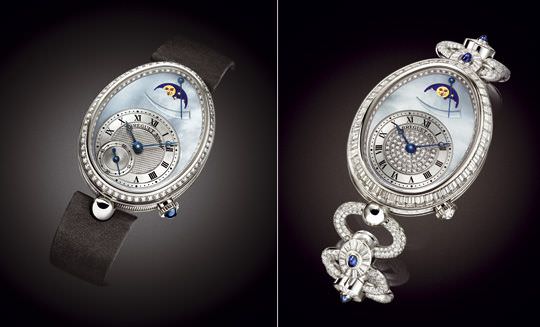
BREGUET TRADITION 7027
Nicolas G. Hayek, who receives us in his office in Bienne, is visibly very proud of the road travelled by Breguet since he acquired the company (along with Nouvelle Lemania, now called Manufacture Breguet) at the end of 1999. The figures speak for themselves: “In 2000, Breguet’s turnover was about 40 million Swiss francs. Today, it is nearing 400 million!”
It is true that the growth rate of Breguet, according to Hayek, has been nothing short of amazing, and amounts to “an increase of between 25 percent and 42 percent per year,” affirms its President, adding that, in 2005, its company saw the number of pieces “increase by 45 percent and its turnover increase by 35 percent. There is a real appreciation for the brand on many markets. Everyone wants a Breguet. We have gone from 2,000 pieces per year to 17,000 pieces today, and we must also add the jewellery and accessories lines.”
A personal challenge
The distance travelled by Breguet over the last six years is indeed impressive, not only quanti-tatively, but also qualitatively, and Nicolas Hayek has made this a personal challenge. To have his name associated with the renaissance of the most revered patrimony in the history of watchmaking, and on this vast a scale, was certainly an attractive idea to the man who had already contributed to another renaissance, quite simply that of the Swiss watch industry.
Since the beginning of Breguet’s acquisition by the Swatch Group, Nicolas Hayek has taken things in hand personally, both in terms of technical development and design. In a very short time, the brand has succeeded in re-imposing its codes and distinctive symbols in the world of Haute Horlogerie: very readable gold dials decorated with fine guilloché, the typical positioning of their sub-dials and their sectors (introduced by Breguet in 1786), cases in three parts with fine knurling on the case band, distinctive lugs finished by rollers linked by a screw-threaded gold stem and blued steel hands with tips in the form of a hollowed out apple (Breguet 1783).
Two models swimming (successfully) against the tide
Last year, however, saw the launch of two watches that differ from these strict canons. Both are especially noteworthy - the feminine Reine de Naples and the very remarkable Tradition.
Inspired by the very first wristwatch, which was created for Caroline Murat by Breguet, the new Reine de Naples line has made quite an impression with its very particular oval shape. Resolutely counter-current to the trends (just think for a moment about the large sports watches being worn by women today, or for a different look, the chic minimalism that is still in fashion), the Reine de Naples has re-introduced ornamental richness in ladies’ watches. Because of its success, it is now available in a series of different versions.
Following this launch, Nicolas Hayek suggests the next creation, this time created for the anniversary of England’s Queen Elizabeth II. This timekeeper also goes against current trends and will be the replica of a watch made for Queen Victoria in 1838. Bearing the number 5102, and, according to a description found in the archives, it is ‘a very small, simple and very flat watch, with a gold guilloché case, exocentric gold dial, steel hands, hour corrector on the side of the case next to the pendant, a self-regulating watch in a small gold guilloché case that opens on the side with the aid of a gold lip…’
In a completely other domain, the Tradition has also been recognized as being one of the leading watches of the year. Inspired by a subscription timepiece, this creation showcases one of Breguet’s important inventions: the shock absorber, developed in 1790 to protect the axis of the balance in case of a jolt or bump. The dial and the transparent sapphire caseback reveal the genius and beauty of this mechanism. Sturdily built, this watch shows off its bridges, gear wheels, escapement, barrel and other components of the movement, which are normally found under the plate. This rather unusual encounter between a certain avant-gardism and the highest tradition of watchmaking is a definite achievement for the brand. Building upon its success, the Tradition is going to become “an entire family,” says Nicolas Hayek. “New complications will be added, and every year until 2010, we will introduce a new Tradition.”

Renaissance of a manufacture
With the Tradition, Breguet has been able to demonstrate its mastery not only in terms of the art of watchmaking, but also in terms of decoration. The bridges and plates have simple graining, based on a finishing technique with a uniformity and regularity that requires a great deal of savoir faire.
Nicolas Hayek also insists on this particular point. The Breguet manufacture, which today employs 550 people (“and each day, I sign new letters of employment,” says Hayek), intends to extend its advance into the domain of decoration. In this regard, an ambitious training program, most notably for teaching the guilloché technique (a disappearing skill), is in the launch phase.
“We have projects in the pipeline until 2016,” affirms Hayek, “and today, 35 new items are being developed. We are also making great changes in the technology of a movement.” With this remark, Nicolas Hayek is alluding to two new movements equipped with silicon components that he expects to present at this year’s BaselWorld. Developed in collaboration with Patek Philippe and Rolex, this new technology, with gear wheel, pallets and balance spring all made in silicon, is expected to give the movements better performance and make them more reliable. However, Hayek has announced that his company Nivarox-FAR is currently investing in a new production line dedicated to the special fabrication of these components.
Breguet’s progress is vigorously supported by a strong commercial policy. International exhibitions, cultural sponsorships (Breguet is going to sponsor the renovation of the Petit Trianon at Versailles), and the opening of Breguet boutiques will happen over the course of the year. The brand’s leading markets “in order,” says Hayek, “are Hong Kong, Russia (with the Ukraine
and Kazakhstan), the Middle East, the USA, Singapore, Malaysia, Japan, Italy, Switzerland, Taiwan, Germany, France, etc...etc..."
The average price? Difficult to say, but probably around 11,000 Swiss francs. The entry level price tag for the Reine de Naples is 31,000 francs but certain versions can climb to 250,000 or 300,000 Swiss francs.
All this does not even count the line of Breguet jewellery that seemingly is beginning to take off as well. Get the calculators out!

REINE DE NAPLES
Source: February - March 2006 Issue





